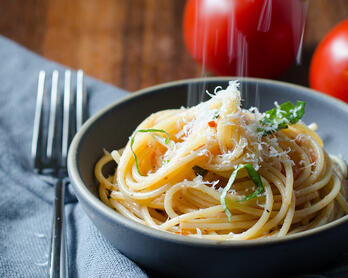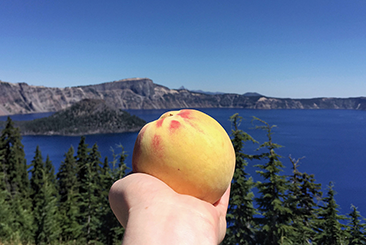Murray's Cheese Shop Classic Mac & Cheese

Rob and I were in New York for a month last year and ate just about everything - 43 coffee shops, restaurants, and bakeries to be exact. Murray's Cheese Bar is one of the spots we tried and would recommend. Fun vibe and location, excellent service, and all of the dishes from fried kale to the burger left us satisfied. The macaroni & cheese was especially delicious so I googled around for a recipe and happened upon the Murray's Cheese Shop blog which features their Classic Mac & Cheese. Yes, please! Not only is the recipe excellent, but Murray's method for infusing the milk with flavor is a brilliant and endlessly adaptable step.
This post includes some background information on alpine cheeses and how to substitute if you can't find the exact types listed in the recipe.
But first, cheese.
What's an alpine cheese?
Two of the cheeses in this recipe - Gruyère and fontina - are of the alpine variety. What makes alpine cheese distinct is that the milk comes from cows, goats, and sheep that spend their summers grazing in the Alps, a mountain range stretching across several countries including Switzerland, Austria, Italy, and France. Where animals live and eat makes a detectable difference in the milk they produce. For this reason, the sweet grass, wildflowers, and diversity of microclimates in the Alps produces an incredible array of flavors. NPR discusses the science behind environment, milk, and cheese in this article.
I didn't fully grasp how diverse the alpine family of cheese was until I started researching for this post. Though the following list barely scratches the surface, below are examples of how geographically far-reaching it is:
- Austria - Hubaner
- Italy - Fontina Val d’Aosta
- France - Comté and Beaufort
- Switzerland - Emmentaler, Raclette, and Scharfe Maxx
- Germany - Adelegger (This cheese is very cool in that it's made by one woman - Evelyn Wilde.)
The process by which cows and sheep make their way to summer pastures is called "transhumance". Though it sounds like something out of the movie Gattaca, transhumance actually dates back as far as the Bronze Age (11th century BCE). It's an ancient practice whereby farmers walk herds slowly up the mountain, stopping only to eat and sleep until they reach their summer home. Unfortunately, the tradition of transhumance has in most instances been replaced by trucking the animals to higher ground. In this short documentary, shepherd Jean-Paul Molière discusses how trucking is not optimal for the health of the animals in terms of acclimating to elevation and climate changes. The silver lining is that consumers and the food community recognize that happier animals make better-tasting milk and cheese so an effort is underway to preserve the practice.
Though not alpine, caciocavallo is another wonderful Italian cheese made from the milk of cows that summer at higher ground. I wrote a post about caciocavallo here and included some fantastic pizza inspiration.
Substituting Cheeses
The beauty of macaroni & cheese is that there aren't any hard and fast rules. Cheese blends are a matter of personal taste so you can mix and match any number of different ways. That being said, here are some substitutes for this recipe if you can't find the specific cheese but want to maintain the spirit of Murray's Cheese Shop's original dish.
- Cabot Cheddar is generally easy to find or you can substitute a sharp white cheddar that still has some sweetness.
- Spring Brook Reading is described on The Murray's Cheese Shop site as, "An American artisanal version of the famous Alpine melter Raclette which means 'to scrape'". A traditional raclette dish involves softening/melting the cheese next to a fire or under a heating element and then scraping the gooey goodness onto bread or a plate to be paired with a variety of accompaniments. Yum! If you can't find Raclette for this recipe, consider increasing both the fontina and Comté (or quality Gruyère) in its place. Raclette has an earthy and funky taste so using a little more Comté than fontina will probably strike the right balance since fontina tends to be on the milder side.
- Fontina Val d'Aosta is a fontina from the Val d'Aosta region of Italy (self-explanatory I suppose). Cheeses that use the name "fontina" aren't hard to find, but many of the available products are lacking in proper flavor development. Fontal, fontella, and fontinella are names you might see but these cheeses aren't fontina. When possible, use Fontina Val d'Aosta or "Italian fontina" for this recipe, the latter having a brown rind.
- Comté St. Antoine is a type of Gruyère produced in the Jura Massif region of Eastern France. Generally speaking, a quality Gruyère that has been aged 6-12 months will be a fine substitute.
What's the difference between a roux, béchamel, and mornay sauce?
I had to ask The Google to clarify the difference between a mornay sauce and béchamel, and then specifically if a mornay sauce contains eggs. The answer to the latter seems to be "no". Here's a quick breakdown:
- Roux - Flour and a fat (often butter) cooked together to use as a thickening agent.
- Béchamel - Roux with milk added.
- Mornay - Béchamel with Gruyère and sometimes cheddar added - basically a cheese sauce.

Farmers | Artisans
I make an effort to source my food from local California artisans with a special focus on the Santa Monica Farmers Market. Below is a list of the talented folks who contributed to this dish.
- Maggie's Farm / Thyme
- Milliken Family Farms / Heirloom Garlic
- Polito Family Farms / Lemon
- Grist & Toll / Flour
- Andrew's Cheese Shop / Cheese
- Murray's Cheese Shop / Recipe
Tools
- Dutch Oven - I prefer using an enamel pot for mac & cheese since it's easier to clean off all the gooey goodness.
- Whisk (also here or here)

Ingredients (makes 4 servings)
Mac & Cheese
- 4 ounces grated Fontina Val d’Aosta
- 4 ounces grated Spring Brook Reading
- 3 ounces grated Comté St. Antoine
- 1 ounce grated Cabot Cheddar
- 1/2 small yellow onion, skin removed
- Small bay leaf
- 1 whole clove garlic
- 2 cups whole milk
- 4 tablespoons butter
- 1/4 cup all-purpose flour
- 1/4 teaspoon freshly ground nutmeg
- 1/4 teaspoon freshly ground black pepper
- 1/8 teaspoon ground cayenne
- 1/2 pound (8 ounces) elbow macaroni or cavatappi Note: I prefer cavatappi.
Breadcrumbs
- 3 teaspoons lightly salted or unsalted butter, melted Note: I use Vermont Creamery's lightly salted butter.
- 1/2 cup breadcrumbs (instructions below)
- 1 sprig fresh thyme, leaves removed and minced
- 1 small lemon
Instructions
Breadcrumbs (I prefer to do this in advance. Breadcrumbs can be frozen and are worth the effort.)
- Move oven rack to the middle position and preheat to 300.
- Line a baking sheet with tinfoil for easy cleanup.
- Remove the crust from 4-6 slices of bread (sourdough, French, etc.), tear into 1 1/2-inch pieces, and arrange in a single layer on the baking sheet. Note: You want to use fresh bread, not stale.
- Bake until the bread is completely dried out, tossing once or twice for even drying, then set aside to cool. Note: Timing depends on how moist the bread is and can range anywhere from 20-40 minutes.
- Pulse the cooled bread cubes in a food processor until ground into a fine crumb.
- Freeze for future use if making in advance.
Pre-bake
- Move oven rack to the middle position and preheat to 350.
- Line a baking sheet with tinfoil and set aside.
- Rub the inside of the baking dish or individual baking dishes with butter.
Infused Milk
- Cut a slit in the onion, then wedge the clove and bay leaf into the slit.
- Add the milk and stuffed onion (cut-side down) to a small saucepan. Bring to a gentle simmer, cover, and cook for 15-20 minutes while you prepare the rest of the ingredients. Check on the milk once or twice and adjust the heat as needed.
- Remove the stuffed onion and discard. Note: If the milk is done before you're ready to finish the mac & cheese, turn off the heat and leave the pot covered so the milk stays warm.
Pasta and Mornay Sauce
- In a Dutch oven or similar pot, cook the pasta per the instructions and drain. Set aside. Note: Salt the water generously before adding the pasta and don't rinse the cooked noodles.
- Wipe the pot clean/dry.
- Over medium heat, melt the butter, sprinkle the flour evenly over top, and whisk for about 2 minutes.
- Add the garlic, nutmeg, pepper, and ground cayenne. Stir until fragrant (about 1 minute).
- Slowly add the warm milk, whisking constantly until the mixture bubbles.
- Lower the heat, whisk in the cheese in two additions, then turn off the heat when the cheese is just about incorporated. Continue to whisk until all of the cheese has melted.
- Optional: I find that this cheese combo needs a little pinch of salt. Chef's discretion.
- Add the pasta to the mornay sauce and stir to combine.
Bake
- Combine 1/2 cup breadcrumbs with 3 teaspoons melted butter, a few swipes of lemon zest, and thyme, then set aside.
- Transfer the macaroni and cheese to the baking dish or individual baking dishes and top with breadcrumbs.
- Place on the foil-lined baking sheet and bake for 20 minutes. Serve immediately.
Scenes From NYC
Rob and I walked from the Meatpacking District to Murray's Cheese Bar and caught this sunset on the way. NYC gives good light.






